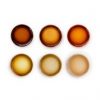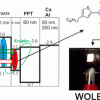100 Club
-

86. Polymeric peptide pigments with sequence-encoded properties
Science 2017 356 1064.
Lampel, A.; McPhee, S. A.; Park, H-A.; Scott, G. G.; Humagain, S.; Hekstra, D. R.; Barney Yoo, B.; Frederix, P. W. J. M.; Li, T-D.; Abzalimov, R. R.; Greenbaum, S. G.; Tuttle, T.; Hu, C.; Betting, C. J.; Ulijn, R. V.
Science 2017 356 1064.
-

83. An Ambipolar BODIPY Derivative for a White Exciplex OLED and Cholesteric Liquid Crystal Laser toward Multifunctional Devices
ACS Appl. Mater. Interfaces 2017 9 4750.
Chapran, M.; Angioni, E.; Findlay, N. J.; Breig, B.; Vladyslav Cherpak, V.; Stakhira, P.; Tuttle, T.; Volyniuk, D.; Grazulevicius, J. V.; Nastishin, Y. A.; Lavrentovich, O. D.; Skabara, P. J.
ACS Appl. Mater. Interfaces 2017 9 4750.
-

78. KOtBu: A Privileged Reagent for Electron Transfer Reactions?
J. Am. Chem. Soc. 2016 138 7402.
Barham, J. P.; Coulthard, G.; Emery, K. J.; Doni, E.; Cumine, F.; Nocera, G.; John, M. P.; Berlouis, L. E. A.; McGuire, T.; Tuttle, T.; Murphy, J. A.
J. Am. Chem. Soc. 2016 138 7402.
-

67. Exploring the sequence space for (tri-)peptide self-assembly to design and discover new hydrogels
Peptides that self-assemble into nanostructures are of tremendous interest for biological, medical, photonic and nanotechnological applications. The enormous sequence space that is available from 20 amino acids probably harbours many interesting candidates, but it is currently not possible to predict supramolecular behaviour from sequence alone. Here, we demonstrate computational tools to screen for the aqueous […]
Frederix, P. W. J. M.; Scott, G. G.; Abul-Haija, Y. M.; Kalafatovic, D.; Pappas, C. G.; Javid, N.; Hunt, N. T.; Ulijn, R. V.; Tuttle, T.
Nature Chem. 2015 7 30








